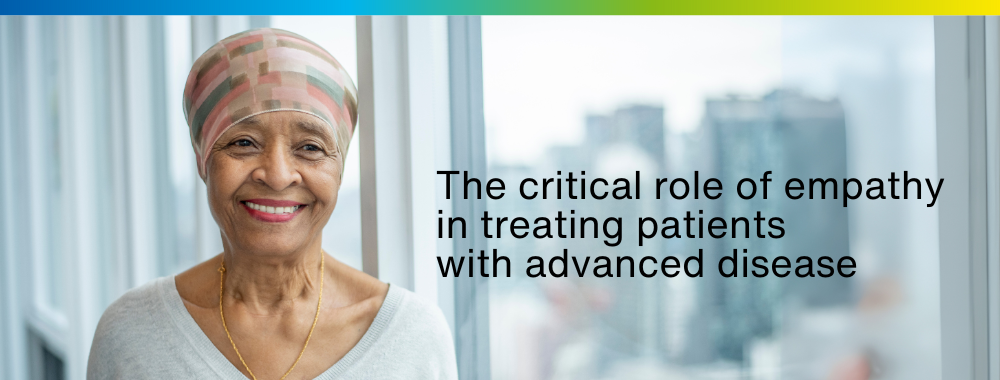
Each patient journey is unique for those faced with a breast cancer diagnosis. At Daiichi Sankyo, we strive to deepen our understanding beyond the scientific aspects, distinguishing between the personal needs of patients with early-stage breast cancer versus metastatic breast cancer. We recognize that for those facing metastatic breast cancer, the path takes a different turn – one where our focus must shift from cure to care that prioritizes living well with the cancer.
How is a Metastatic Breast Cancer Diagnosis Different for Patients?
The course of action for patients diagnosed with metastatic breast cancer is fundamentally different from that of patients with early-stage breast cancer. Early-stage breast cancer is typically approached with the goal of achieving a cure. However, for patients with metastatic disease, the road pivots towards prolonging survival and safeguarding quality of life.
Treatment is highly individualized, taking into account factors such as the location of metastasis, previous treatments, overall health and personal preferences. A metastatic diagnosis can also affect personal relationships, work life, and daily activities, necessitating adjustments and support.
How is the Treatment Journey for Metastatic Patients Different?
Metastatic breast cancer is defined as the disease spreading to other organs throughout the body, making it more challenging to treat. As a result, treatment decisions become highly personalized, focusing not only on efficacy and time without disease progression, but also on minimizing side effects and preserving a sense of control over daily life.
When breast cancer is diagnosed at or progresses to a metastatic stage, it is essential for patients to collaborate closely with their healthcare providers. This partnership involves thoroughly exploring all available treatment options and reassessing any changes that might influence treatment recommendations.
The HER2 status of a tumor may have changed over time which can impact treatment decisions. A doctor may recommend retesting for HER2 expression (human epidermal growth factor receptor 2), a protein in breast cancer cells that can promote cell growth.
What Does this Mean for the Well-Being of the Patient?
When facing metastatic disease, the emotional landscape may vary significantly from person to person. Some individuals may experience feelings of hopelessness or become overwhelmed by their emotions. Others might find themselves questioning the decisions they made during their previous treatments. Despite these challenges, hope can still exist, though it is often reshaped by the realities of living with an illness. Support groups and working with mental health professionals are highly recommended with any cancer diagnosis.
 Patricia Judson, M.D., Vice President U.S. Medical Affairs
Patricia Judson, M.D., Vice President U.S. Medical Affairs
Navigating Each Day with Strength, Clarity and Choice
“For individuals diagnosed with metastatic breast cancer, recognizing the different tone and their unique needs is critical. Given the improbability of a cure that comes with metastatic breast cancer, patients often feel alienated by the optimistic messaging that surrounds early-breast cancer and the ‘pink ribbon’ community. We celebrate alongside the patients diagnosed with early-stage breast cancer who are able to ring the bell to commemorate the end of treatment. For people living with metastatic breast cancer, the journey is not as easy. It's about navigating each day with strength, clarity, and choice. These individuals don't need slogans, they need real options, real support, and to be truly seen for the complexity of their experience.”
How Can the Needs of Patients with Metastatic Breast Cancer be Acknowledged and Addressed?
Everyone from healthcare providers, to caregivers, or researchers developing treatments should acknowledge and address the true experiences and challenges faced by people with metastatic breast cancer. The patient’s reality must be treated with respect at every interaction, which involves listening to their concerns, valuing their input and recognizing their individuality. The complexity of metastatic breast cancer must be presented with honesty and relevance through communications tailored to and supportive of their circumstances.
By truly listening to and understanding the needs of patients with metastatic breast cancer, we can offer meaningful options and foster a community that respects and reflects their experiences. This commitment to understanding and support is essential to improving the lives of those living with metastatic breast cancer.
Learn more about what makes metastatic breast cancer different in part 1 of this series: "Understanding Metastatic Breast Cancer: Exploring the Science."
Suggestions
Growing up in a Spanish-speaking home, I was the family translator—a role that became particularly challenging when my mother was diagnosed with breast cancer. My family relied on me…
Each patient journey is unique for those faced with a breast cancer diagnosis. At Daiichi Sankyo, we strive to deepen our understanding beyond the scientific aspects, distinguishing between the personal needs of patients with early-stage versus metastatic breast cancer.
Informed patients are empowered patients. Which is why helping people with cancer understand their disease, as well as how available treatment options might work for them, is a critical focus of our patient advocacy efforts.